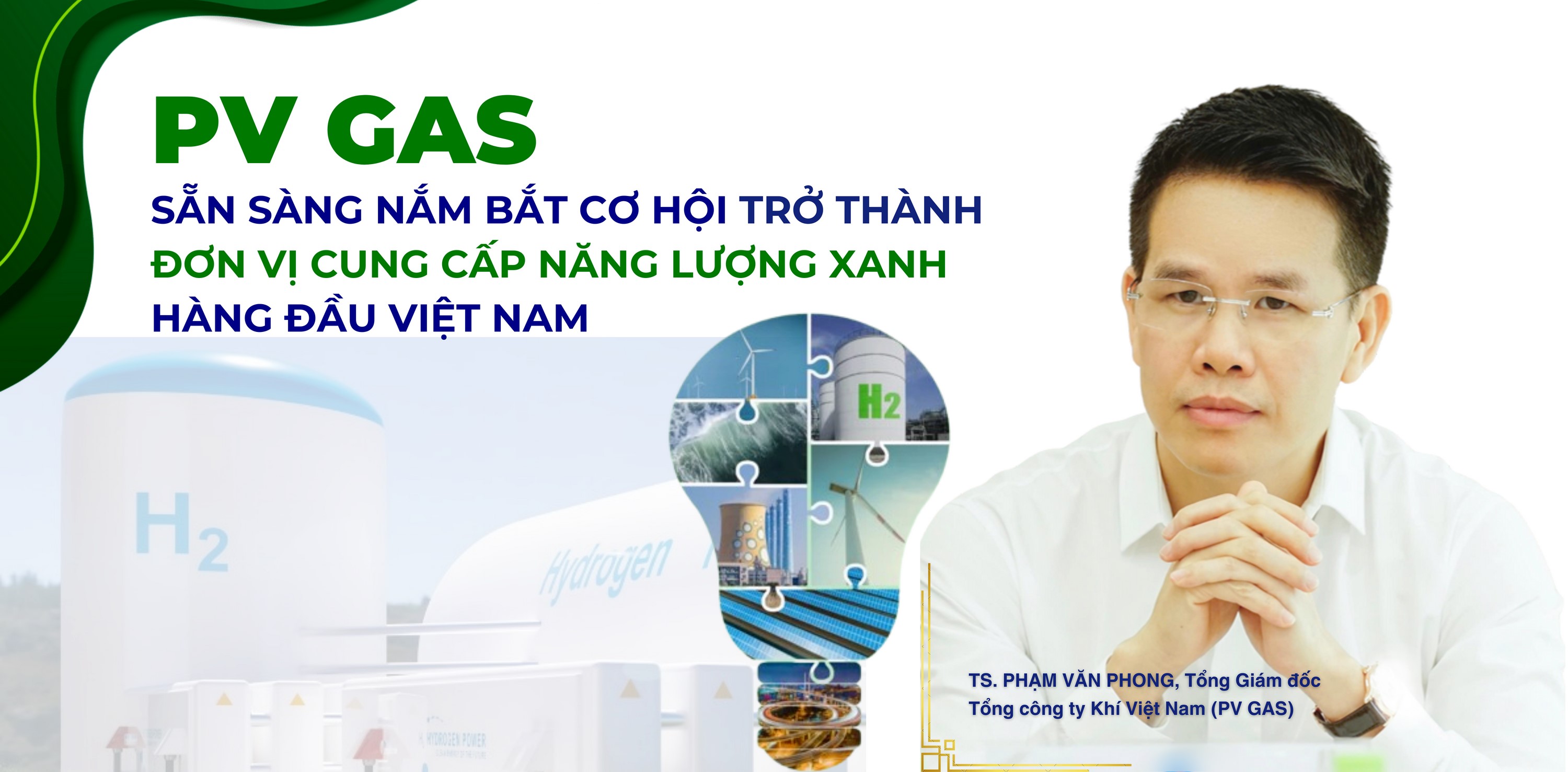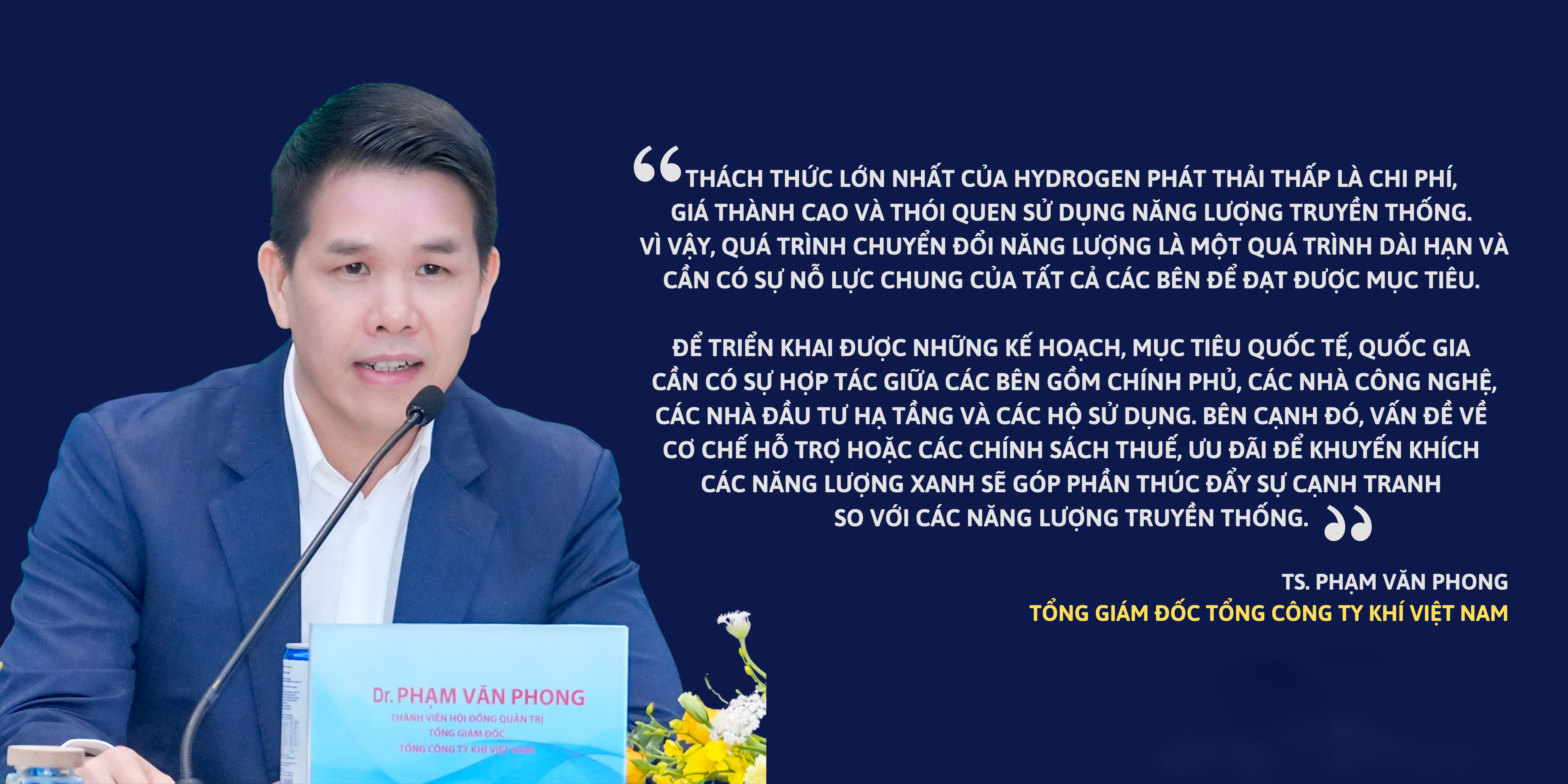PV GAS ready to become Vietnam's leading green energy provider
Low-emission hydrogen (H2) is considered a key factor for a carbon-neutral economy. PV GAS is a pioneer in research and development (R&D) as well as in promoting the production and use of low-emission H2 in Vietnam. On the occasion of welcoming the new year 2025, Dr. Pham Van Phong, CEO & President of PV GAS, recently had an interview with journalists about the role of the Corporation in providing clean energy for the country's socio-economic development.

Vietnam, with its promising potential for renewable energy, is seen as an ideal location for producing green H2, one of the low-emission H2 types. The government has issued policies and strategies to promote the development of this new form of energy.
To be specific, the Politburo issued Resolution No. 55-NQ/TW on the strategic orientation for Vietnam's national energy development to 2030, with a vision to 2045, emphasizing the development of H2 energy. Prime Minister's Decision No. 893/QD-TTg approved the National Energy Master Plan for the period 2021-2030, with a vision to 2050, including goals for green H2 development. On February 7, 2024, under Decision No. 165/QD-TTg, the government also issued Vietnam's H2 Energy Development Strategy to 2030, with a vision to 2050.
These policies aim to create a legal framework and favorable conditions for the introduction of the low-emission H2 industry in Vietnam.
Interviewer: What specific plans do Vietnam Oil and Gas Group (PVN) and PV GAS have to develop low-emission H2 in the context of Vietnam's national energy strategy to 2030 and vision to 2050?
Dr. Pham Van Phong: PVN/PV GAS has collaborated with ministries and sectors to develop the National Energy Development Strategy and Vietnam's H2 Development Strategy to 2030, with a vision to 2050, with alignment with the Prime Minister's commitments at COP26 and Vietnam's practical conditions.
To optimize infrastructure and operational advantages, PVN has directed PV GAS to take the lead in researching solutions for the production, storage, distribution, and use of low-emission H2, as well as exploring, evaluating, and developing markets for the consumption and exportation of this new form of energy.
These technologies include electrolysis, CCS/CCUS, pipeline transportation, high-pressure tanker transportation, liquefaction, and solid-state H2 adsorption.
Results show that utilizing PV GAS' natural gas pipeline infrastructure for H2 transportation is technically feasible and helps reduce initial investment costs. Thefore, the Corporation will continue to collaborate with PVN's production chain units to review and propose specific implementation plans.
Additionally, PV GAS is researching H2 projects, besides LNG import and distribution projects in Vietnam, along with studying small-scale pilot projects to produce and supply green H2 to industrial users and the transportation sector in the Southeast region. The Corporation is evaluating opportunities to leverage existing infrastructure for the production, transportation, supply, and export of green derivatives such as green ammonia, methanol, and e-methane.
Interviewer: Which research organizations is PV GAS collaborating with to develop low-emission H2 production technologies? Have any research or demonstration projects been implemented? What plans does the Corporation have to promote technology transfer and apply scientific advancements in low-emission H2 production?
Dr. Pham Van Phong: PV GAS has a clear direction in researching, accessing, and applying new technologies in the H2 industry, as mentioned earlier. Currently, we are researching small-scale green H2 production and supply projects for industrial users in the Southeast region, using solar-powered electrolysis to produce green H2.
The electrolysis technology is expected to use PEM or AKL, along with high-pressure H2 storage and transportation technologies, and systems for supplying H2 to combustion and consumer systems, as well as for transportation vehicles.
The project requires collaboration and contributions from various stakeholders, including technology licensors, equipment suppliers, green financial institutions, consumers, and international green development organizations, to receive government incentives.
Currently, PV GAS is collaborating with GIZ to register a pilot project under the PPP (Public-Private Partnership) program funded by the German government. PV GAS is also discussing cooperation with Japan's JICA and JETRO on low-emission H2 initiatives. Additionally, PV GAS is partnering with domestic and international businesses, technology providers, banks, and green financial institutions to implement energy transition and green production projects.

Interviewer: How will PV GAS balance the development of green H2 with traditional energy sources? What do you see as the biggest challenge in developing and applying green H2 in Vietnam? What solutions does the Corporation have to overcome these challenges?
Dr. Pham Van Phong: The biggest challenge for low-emission H2 is its high cost and the traditional energy usage tendency. Therefore, the energy transition is a long-term process that requires the collective effort of all parties to achieve the set goals.
To implement international and national plans and goals, collaboration is needed among the government, technology providers, infrastructure investors, and consumers. Additionally, supportive mechanisms or tax policies and incentives to encourage green energy will help promote its competitiveness against traditional energy sources.
PV GAS is determined to be a pioneer in providing green energy in Vietnam. Therefore, we will intensify R&D efforts and effective collaborations to advance these goals.
We will start with small-scale pilot projects. At the same time, we are also interested in developing opportunities for potential commercial projects. We believe that our strengths in infrastructure, experience, and human resources are crucial factors in gaining advantages in this new and challenging field of green H2, green ammonia, and green energy products in general.
Interviewer: What opportunities does low-emission H2 present for PV GAS and Vietnam's energy sector in the future? Do PVN and PV GAS have plans to convert pipeline transportation and distribution systems, storage facilities, and gas stations to accommodate H2?
Dr. Pham Van Phong: The energy transition to address climate change is an inevitable global trend and goal, and Vietnam cannot be ignorant. The challenges for low-emission H2 to compete with traditional energy sources are significant, including cost, technology, and market habits.
However, there are many new opportunities for pioneers. PV GAS is aiming at becoming Vietnam's leading green energy provider, and we are ready to seize these opportunities.
First, we are researching partial conversion to use infrastructure for transporting and storing green H2 and green ammonia. Next, we will conduct practical commissioning to evaluate and propose technical solutions to ensure safety and efficiency.
In the long term, as demand increases, we plan to expand existing infrastructure according to international standards for H2 and ammonia to serve PV GAS' strategy for green energy production and supply.
Interviewer: What strategies does PV GAS have to develop the market for green H2 consumption in Vietnam and internationally?
Dr. Pham Van Phong: We will work with consumers, suppliers, and domestic and international partners to develop solutions to achieve common goals. As I mentioned, PV GAS' strengths in infrastructure, experience, human resources, and other resources are crucial.
Additionally, we believe in leveraging effective collaborations to implement these new fields, along with government support, particularly in policy mechanisms and the allocation of green financial resources for low-emission H2 projects. Through PVN, PV GAS has registered several projects for financial support from JETP and hopes for approval.
(Ngọc Linh - Mekong ASEAN)